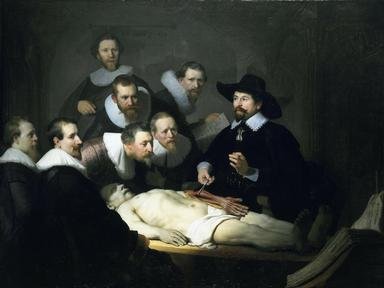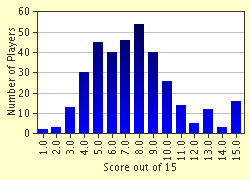Quiz Answer Key and Fun Facts
1. "The Sortie of Captain Frans Banning Cocq's Company" is the correct title of this famous painting, usually called by its much shorter (but inaccurate) title.
2. Rembrandt painted at least three portraits of his mother.
3. Rembrandt painted both his wife, Saskia, and Hendrickje Stoffels in the person of this Roman goddess of the Spring, crowned with flowers.
4. There are two paintings by Rembrandt of this dramatic scene of recognition from the New Testament. In the first, Christ is shown in profile, dramatically silhouetted against the light. In the second, he is fully lit in the center of the painting.
5. Rembrandt, along with many of his contemporaries, was a great admirer of the Italian painter Caravaggio. His painting of this gruesome Biblical scene appears to have been influenced by Caravaggio's "Martyrdom of St. Matthew", as well as Ruben's "Prometheus Bound".
6. Rembrandt lived among many Jewish neighbors in Amsterdam, many of whom had emigrated from Portugal and Spain in the wake of the expulsion of the Jews from these countries. He did many portraits of Jews and genre paintings of Jewish life. Which of the following is NOT a painting, but an etching?
7. Rembrandt was also known to have had many friends of the Jewish faith, including the distinguished Portugese rabbi Menassah Ben Israel. The influence and advice of the latter is believed to be responsible for, among other things, the striking use of written Hebrew text in these two paintings of Old Testament scenes. One depicts a famous Biblical list, the other chillingly depicts the "handwriting on the wall".
8. The couple depicted in the famous painting "The Jewish Bride" also appear, with their two children, in this later painting.
9. This painting, one of Rembrandt's most moving, depicts five people, representing three generations of the same family: an old, bedridden, almost blind man, his two small grandchildren, his son (their father), and the son's wife, an Egyptian princess.
10. In addition to his paintings and sketches of his Jewish neighbors, Rembrandt also did some notable paintings featuring people of African origin.
11. Rembrandt did several paintings of his son Titus. In one of these, he wears a religious habit and is depicted as a member of a religious order founded by this beloved saint.
12. Rembrandt's beloved Titus sadly predeceased his father in 1668, dying of the plague only eight months after he had married. Rembrandt is known for many paintings celebrating the father-son relationship; which of these paintings, now housed in Russia's Hermitage Museum in St. Petersburg, did he paint after the death of his own son?
13. Joseph Heller's 1988 novel "Picture This" is a fascinating work whose action alternates between Rembrandt's own time and ancient Greece before the time of Christ. It describes the completion of one of Rembrandt's greatest paintings, as well as depicting the man who is the subject of the painting. Which painting is it about?
14. Which of the following were NOT subjects known to have been painted by Rembrandt?
15. Rembrandt did more self portraits than probably any other artist in the history of painting. One of his last is sometimes called the "Laughing Self Portrait"; some believe that he is depicting himself as this famous ancient Greek philosopher, known as the "Laughing Philosopher".
Source: Author
jouen58
This quiz was reviewed by FunTrivia editor
Bruyere before going online.
Any errors found in FunTrivia content are routinely corrected through our feedback system.


